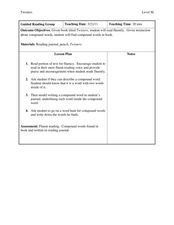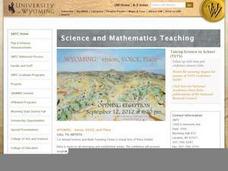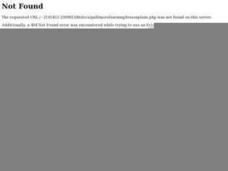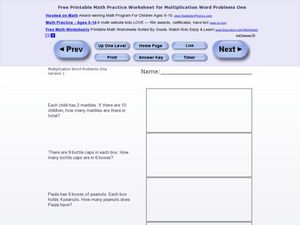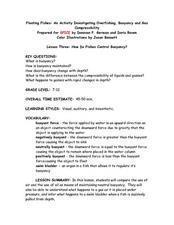Curated OER
Laboratory - Density of a Material
Students conduct a lab (with water, guar gum and sodium borate) and carefully record physical and chemical properties and changes throughout the session, and experiment with weighing by difference.
Curated OER
Relative Size Lesson Plan for First Grade
First graders compare triangle sizes, square sizes, and lengths. They use manipulatives of three varied sized triangles, squares, and strips to measure and compare relative size and length.
Curated OER
More or Less? Mouse or Elephant?
Second graders have fun predicting the relative sizes of answers to addition and subtraction problems using their animal friends. When the lesson is finished, give each student two cookies for a job well done.
Curated OER
Nanaotechnology: Small Science, BIG DEAL!
Pupils read an article that introduces them to the science and applications of nanotechnology. They discuss the the everyday examples of how nanotechnology is and can be used. In small groups, they observe and make inferences about...
Curated OER
Twisters
Students differentiate between the terms 'tornado watch' and 'tornado warning' and simulate the conditions that produce tornadoes. They read "Night of the Twisters" by Ivy Ruckman and conduct an experiment using two-liter plastic...
Curated OER
Probability Plus
Students participate in a variety of activities to understand statistics. They collect and interpret data. Also students distinguish the difference between a population and a sample. They make inferences and create arguments using data.
Curated OER
Dolphins And Penguins
Students participate in an activity that reinforces vertical addition sentences as well as provides facts about penguins. They assess a kinesthetic/visual activity to reinforce the difference between vertical and horizontal addition...
Curated OER
Making a Food Web and Learning About Ecosystems
Third graders examine the difference between a food web and food chain. They also examine the importance of the sun in a food web and food chain. Students understand what happens when you remove parts of the chain.
Curated OER
An Opening Time Line Project
Students create a time line of their life starting at birth and each year after that up to their current age. They write and illustrate one important thing for each year, and place their time lines on poster board.
Curated OER
Creating a Map
Third graders examine the process of creating an accurate map, and create a map of their playground. They identify what objects are on their playground, and discuss what is found on a map. Students then draw a map of their playground...
Curated OER
Disappearing Magic Factors
Students identify, through the number of rows and columns, the factors related to the product. In turn, they also discover how to find the missing factor, which is part of the fact family for that product.
Curated OER
Using the Correct Vocabulary to Solve Problems
Third graders examine the vocabulary and strategies to be used with addition, subtraction, and multiplication word and story problems. They observe the teacher solve a variety of problems, then write and illustrate their own original...
Curated OER
The Journey of a Red Blood Cell
Fifth graders examine how a red blood cell travels throughout the body. Using a model, they follow the flow of blood throughout the entire body. They identify the functions of the lungs and discuss the difference of the blood entering...
Curated OER
Research Lesson on the Dust Bowl
Eleventh graders connect art (photographs) to the historical period and conjecture about conditions during this era in American history, sharing ideas in class discussion. Each student completes a project on a period depicted in one of...
Curated OER
Project Yellow Bus
Students discover the uses of energy and the difference between renewable and nonrenewable resources. They participate in hands-on activities to help them explain the concept of energy.
Curated OER
Coal Production in the USA
Middle schoolers arrange the states by alphabetical order, find the five top coal producing states and discover their total production levels. They then find all the states which begin with the letter "A" and whose coal production is...
Curated OER
Multiplication Word Problems 1 Version 1
In this multiplication worksheet, 2nd graders read and solve 6 word problems in which single digits are multiplied. There is a box next to each problem for students to show their work.
California Academy of Science
Academy Seafood Market and Fishery
What fishing method is the most sustainable? Find out through a fun, but meaningful game in which your little fishermen use different techniques to see what they catch. After the fishing activity is over, there are several discussion...
Granite School District
Kindergarten CCSS Math Vocabulary Word List
Help kindergartners develop the academic language they need to master the Common Core standards with this list of math vocabulary. Including the definitions of each term as well as a set of word cards with supporting images and examples,...
Curated OER
Floating Fishes: How do Fishes Control Buoyancy?
Playing with balloons, water, oil, and bottles help put this lesson over the top! Participants use air-filled balloons in water tanks to experience gas compression. They also use oil-filled bottles to experiment with buoyancy. Included...
Curated OER
Easy Division Without Remainders: 2-Digit Quotient
In this division worksheet, students complete a total of 9 problems; problems have no remainders and 2-digit quotients. Worksheet contains a link to additional activities.
Curated OER
Spaceship Math Addition XAll Problems Practice Version 1
In this addition worksheet, 1st graders find the sums to 40 single digit addition problems. They regroup as needed while practicing basic addition facts.
Curated OER
Multiplication Table: Facts From 1-12
In this multiplication worksheet, students complete a multiplication table with facts from 1- 12. There are some numbers provided as hints.
Curated OER
Fill- In Multiplication Grid Problems 30% Open
In this multiplication worksheet, students fill in a multiplication chart with products from the factors 1 to 12. The chart is 70% filled in and students supply the remaining products.






